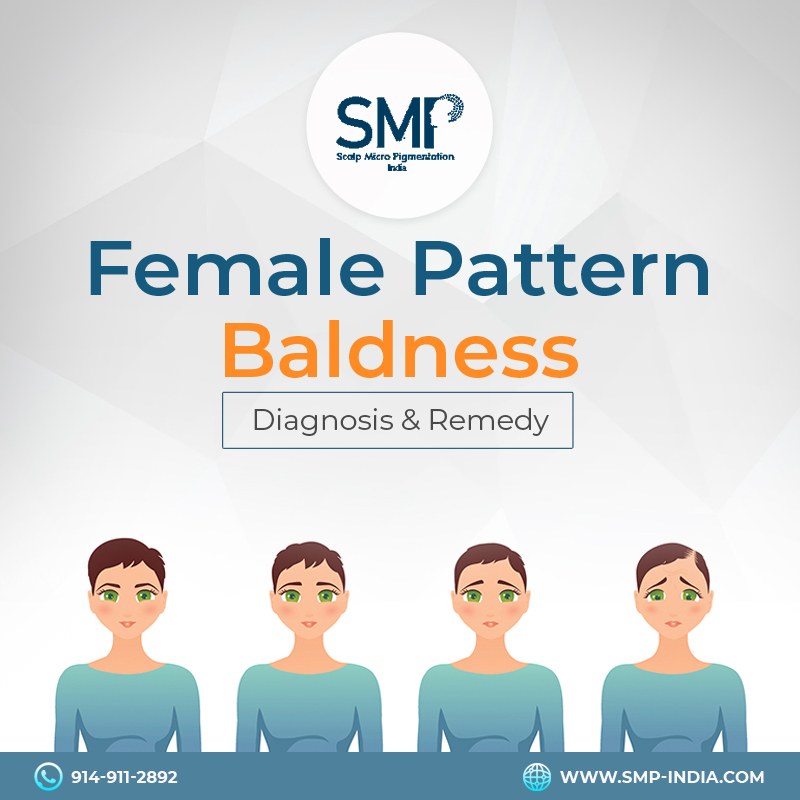The Truth About Female Pattern Baldness – Diagnosis & Remedy

Androgenetic Alopecia or female pattern baldness is a kind of hair loss similar to that of males. The only difference is in the hair loss pattern. While most women face this issue when they are past the age of sixty, or after menopause, this has become more common in today’s date. Identifying the problem, and taking proper steps to treat it is crucial in ensuring it doesn’t have long-term effects. This blog would identify how the condition looks like, what causes it, and how to treat it?
What is Androgenetic Alopecia, and how does it look like?
In a woman, hair loss is quite normal, especially when you start to age. Women who face Androgenetic Alopecia faces general hair thinning, that affects the hair volume. The first stage in a woman is when the parting starts to widen, and it doesn’t feel as thick. The hair follicles shrink, and that makes hair grow thinner and easily breakable. The hairline, however, doesn’t recede but the scalp might be visible. Even though women are less likely to go bald, thinning might happen throughout the hair.
Doctors specialized in the condition divide it into three major types:
- Type 1 where a small amount of thinning starts near the part
- Type 2 where the part widens and the thinning around it increases
- Type 3 where there is absolute thinning
What are the causes of such a condition?
When it comes to Androgenetic Alopecia, the main reason is a hormone-secreting tumour of the underlying endocrine condition. Other causes might include:
- Severe acne
- Irregular period
- Increased unwanted hair
- Physical and emotional stress
- Side effects of medications
- Menopause
- Pregnancy
In case you are sure none of the above can be reasons, contact a qualified doctor immediately.
How to diagnose this condition?
The first thing you should do when you see excessive hair loss is to visit either a hair transplant surgeon or a trichologist. These professionals would examine your scalp and understand the pattern of hair loss you are facing. Several kinds of Trichoscopic tests are performed to understand the cause. Some of these blood tests include checking your thyroid hormone, iron, and androgens. These tests would also determine the treatment options.
Can it be prevented?
Given the fact female pattern baldness might be genetic, it cannot be prevented. Having said that, there are several steps you can take to ensure your hair is healthy. Some of them are:
- Maintaining a diet rich in vitamins, protein, and iron
- Protecting the hair from sun damage
- Avoiding excessive hair styling, straightening, or use of extensions
What is the best treatment for the condition?
The best treatment for Androgenetic Alopecia is transplant surgery. Having said so, various factors contribute to the eligibility factor for the treatment. An easy but permanent way out which can give you immediate results is through Scalp Micropigmentation. This hair tattooing procedure, if performed by experienced surgeons, can render a fuller hair look which you can flaunt to the world.
The best part is that it doesn’t look unnatural at all and instead, gives you an incredible style. It does not come in between the natural cycle of hair growth, and that is what makes it one of the most popular choices for women. Just ensure you visit ABHRS certified doctors for the treatment.
Dr Satya Saraswat and Dr Preeti Saraswat have a particular interest when it comes to the field of hair transplant. Both of them are diplomates of the American Board of Hair Restoration Surgery, making them two highly sought after doctors for the treatment. Dr Satya Saraswat is an MBBS, M.Ch, MS, and also has a DNB in Plastic Surgery; with a Gold medal to his credit. Dr Preeti Saraswat, on the other hand, is a PGDCC from the University of Greifswald.
Conclusion: When it comes to Androgenetic Alopecia or female pattern baldness, Scalp Micropigmentation (SMP) is an exceptional treatment option. Should you want to know more about the service or book an appointment with the doctors for the same, get in touch by dialling +91-914-911-2892.
